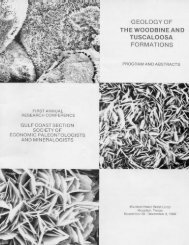Petroleum Systems of Deep-Water Basins - Gulf Coast Section SEPM
Petroleum Systems of Deep-Water Basins - Gulf Coast Section SEPM
Petroleum Systems of Deep-Water Basins - Gulf Coast Section SEPM
You also want an ePaper? Increase the reach of your titles
YUMPU automatically turns print PDFs into web optimized ePapers that Google loves.
The Rio Muni Basin <strong>of</strong> Equatorial Guinea:<br />
A New Hydrocarbon Province<br />
Paul Dailly<br />
Kenny Goh<br />
Phil Lowry<br />
Gene Monson<br />
Triton Energy<br />
6688 North Central Expressway<br />
Dallas, Texas 75206<br />
e-mail: daillyp@tritonenergy.com<br />
Abstract<br />
The Rio Muni basin underlies the continental shelf <strong>of</strong> the west African republic <strong>of</strong> Equatorial Guinea, located<br />
between Gabon and Cameroon. The basin is situated above a section dominated by a northeast-southwest trending<br />
oceanic fracture zone and its continental extension. This fracture zone constitutes the boundary between the Equatorial<br />
Atlantic margin and the West African salt basin.<br />
Despite its location between the prolific hydrocarbon provinces <strong>of</strong> the Niger delta to the north and the Gabon<br />
coastal basin to the south, the Rio Muni basin has been overlooked by the industry for much <strong>of</strong> the last decade. Previous<br />
wells have proved a viable source rock, but no accumulations. Triton Energy licensed Blocks F & G in 1997 and<br />
drilled the Ceiba 1 discovery well in 1999, proving a new hydrocarbon system in the deep water, Late Cretaceous post<br />
rift sequence. Deformation by Santonian-Coniacian transpression caused uplift <strong>of</strong> the shelfal area and deposition <strong>of</strong> a<br />
thick, slope fan sequence. Contemporaneous salt deformation <strong>of</strong> rafted deposits and the development <strong>of</strong> a base <strong>of</strong><br />
slope compressional belt are also evident. The resultant turbidite sequences form the reservoirs in the Ceiba discovery,<br />
which has been tested at 12,400 BOPD. Both Late Cretaceous and Tertiary turbidite reservoirs form exploration targets<br />
in the basin; these may be charged by a deep water source kitchen from which earlier, shelfal wells were<br />
shadowed.<br />
12

















